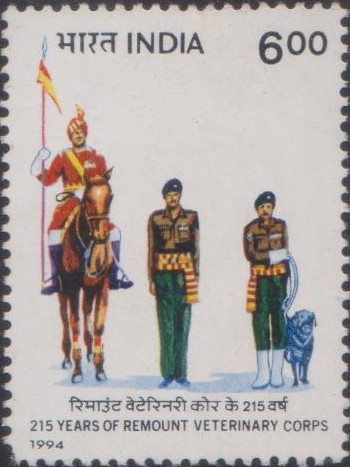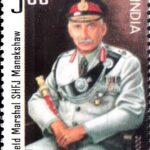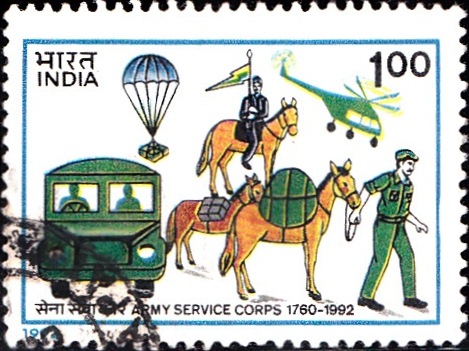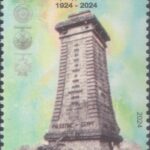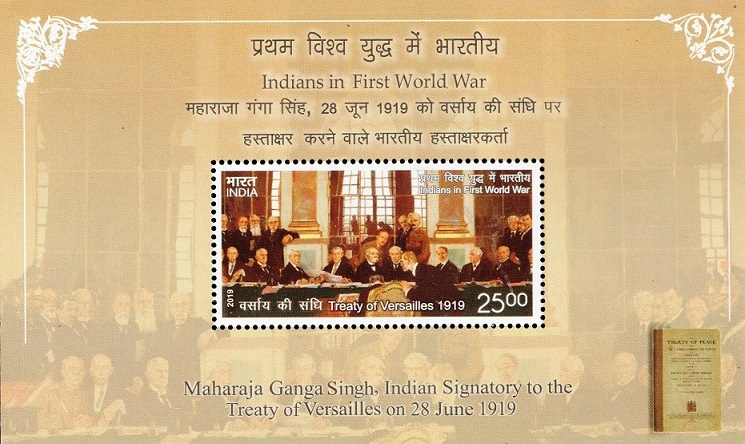
Indians in First World War
4 Miniature Sheets consisting of 15 nos. of commemorative postage stamp on the participation of Indians in the 1st World War : Major Battle Theatres, Air Warriors, Indian War Memorials and Maharaja Ganga Singh (signing of the Treaty of Versailles, 1919) :




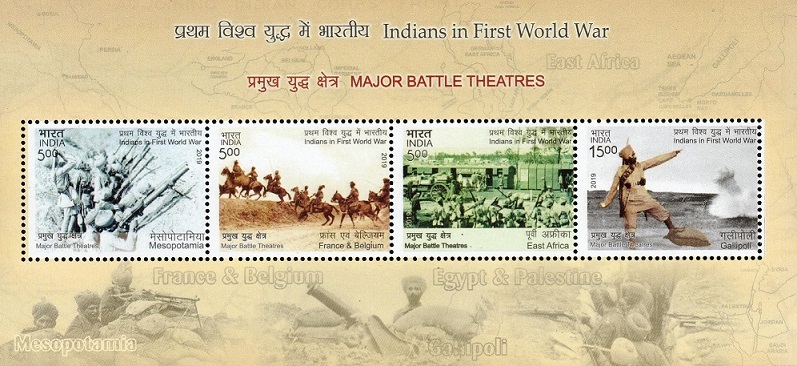
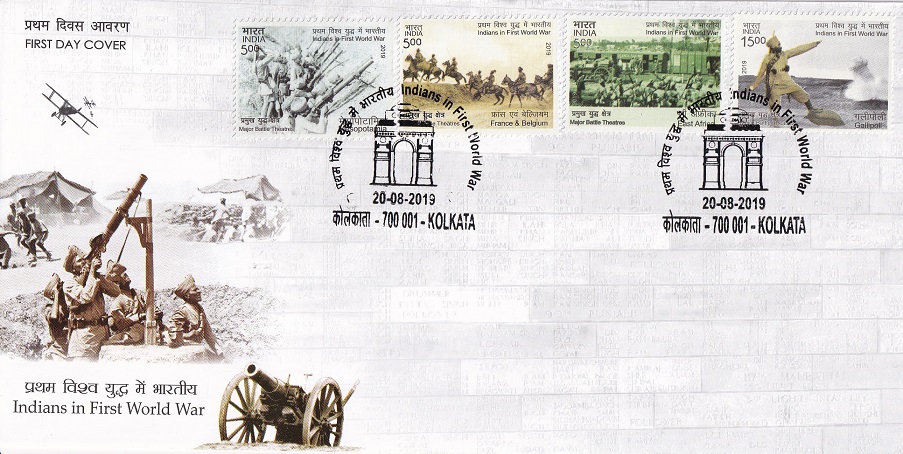




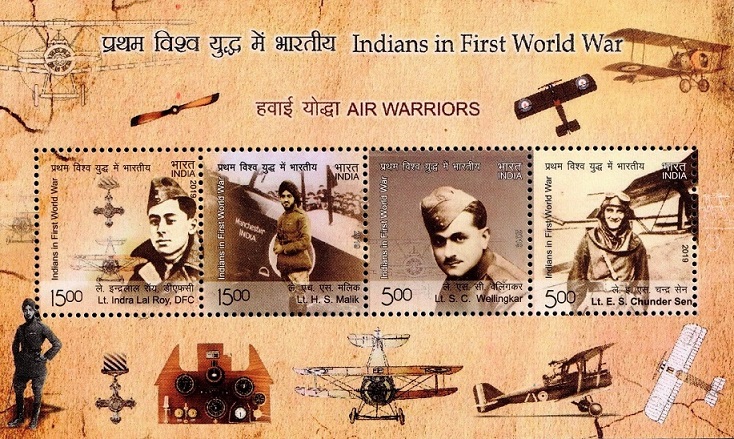
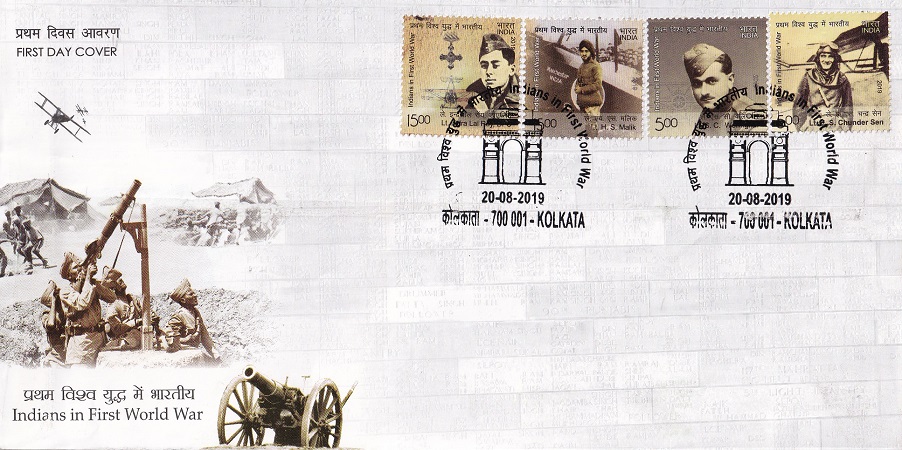






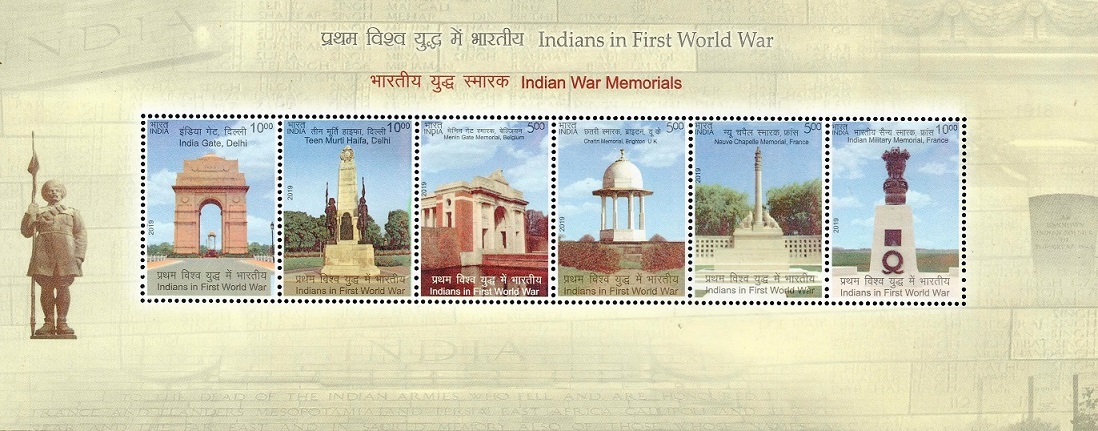
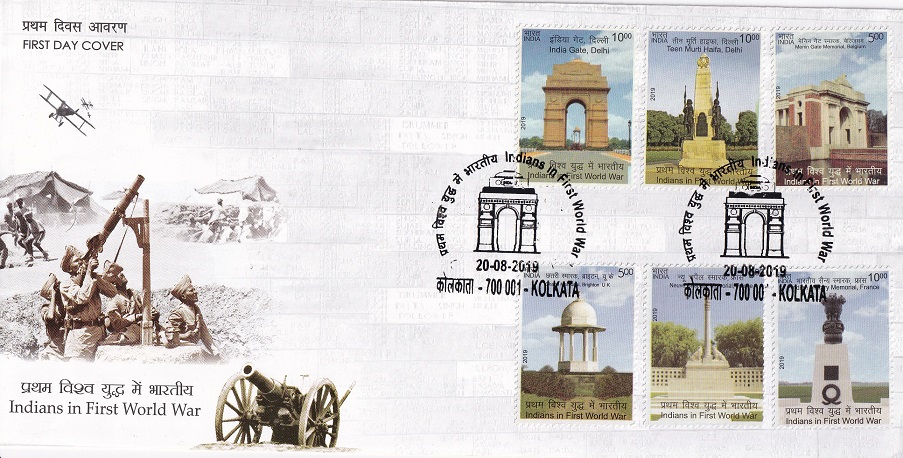


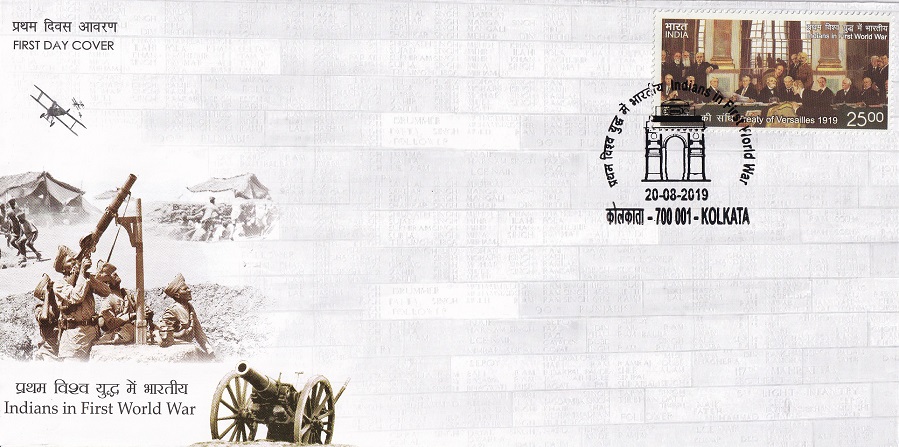
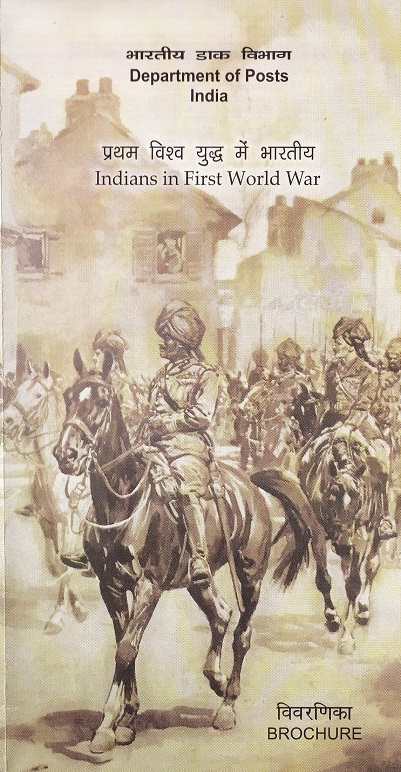 Issued by India
Issued by India
Issued on Aug 20, 2019
Issued for : Department of Posts is pleased to issue a set of four Miniature Sheets on the theme “Indians in First World War” to commemorate the contribution of “Indians in the First World War”.
Credits :
Stamps/Miniature Sheets/FDC/Brochure/Cancellation Cachet : Shri Brahm Prakash (Based on the designs provided by Imperial War Museum, UK and USI, CAFHR, New Delhi)
Type : Miniature Sheets, Mint Condition
Colour : Multi Colour
Denomination : 500 Paise (8), 1000 Paise (3), 1500 Paise (3) and 2500 Paise (1)
Stamps Printed : 500000 each
Miniature sheets printed (4 types) : 1.10 lakh each
Printing Process : Wet Offset
Printer : Security Printing Press, Hyderabad
About :
- The First World War (1914-1918) was a watershed event in modern world history. The events of that conflict changed the social and political map of the world. Though a colony at the time, India actively supported the war effort in its bid to gain Dominion status and contributed immensely in terms of men and material. Indian soldiers served with credit and honour in numerous battlefields around the globe. By the end of the war nearly 14,00,000 Indians had served overseas at the cost of approximately 74,000 dead. They earned over 9,200 decorations for gallantry including 11 Victoria Crosses. These figures include the contribution of over 26,000 Imperial Service troops who were a part of the armies of the semi-autonomous Princely States or Indian States Forces as they were commonly known.
- MAJOR BATTLE THEATRES
- Mesopotamia – In Mesopotamia, after initial setbacks to the designated Indian Expeditionary Force ‘D’, the series of operations which culminated in the capture of Baghdad completely transformed the military situation and produced political effects of far reaching significance. India’s share in the achievement of this important success consisted in providing over three-quarters of the force employed, over three-quarters of the river craft and the entire railway material and personnel, without which the operations would have been impossible. Of the 86 battalions composing the force at the time of the capture of Baghdad, India had contributed 73, and all but two of the 43 squadrons of cavalry. Three Indian soldiers were awarded the Victoria Cross for acts of supreme gallantry in Mesopotamia.
- France and Belgium – Designated Indian Expeditionary Force ‘A’, the Indian Corps that served in France and Belgium from Sep 1914 consisted of two infantry and two cavalry divisions. 85,000 Indian soldiers under 1,500 officers, supported by 26,000 Indian non-combatants, served in the Indian Corps. Indian soldiers fought at the battles of Ypres, Festubert, Givenchy, Neuve Chapelle, Second Ypres, Cambrai and Loos, suffering some 34,252 casualties in the process.
- Gallipoli – The object of the Gallipoli Campaign, from start to finish was to force the passage of the Dardanelles and get a fleet of British and French warships to Constantinople; hoping thereby to force the surrender of Turkey and bring about a speedy conclusion of the war in the Middle East. The Indian Expeditionary Force ‘G’ that served in the Dardanelles was not very large in number; yet it had a significant impact upon the course of the operations and no account of the campaign can ignore the contribution of the 14th Sikhs in the Third Battle of Krithia or the 1/6th Gurkhas in the climactic Battle of Sari Bair.
- AIR WARRIORS
- Lieutenant Indra Lal Roy was credited with shooting down eight German fighter aircraft in aerial combat; he was awarded the Distinguished Flying Cross. He is the only Indian pilot to get the decoration during World War I. He was killed in action in a dogfight against German Fokker D. VIIs aircraft over France on 22 July 1918. He was 19 years old.
- Lieutenant Hardit Singh Malik was the first Indian to be commissioned as an officer into a combatant arm. He flew in No. 28 Squadron, Royal Flying Corps (RFC), in France and served with distinction, ending the war with a German bullet in his leg, which he carried till the end. He became India’s Ambassador to France after independence.
- Lieutenant SG Wellingkar volunteered and joined the Royal Flying Corps and got his wings in April/May 1917 after which he flew a number of combat sorties over France to blunt the German offensives in the summer of 1918. On 27 June, 1918 he was shot down over France and died on 30 June, 1918.
- Lieutenant Erroll Suvo Chunder Sen was an Indian pilot who served in the Royal Flying Corps during the First World War and was among the first Indian military aviators. His grandfather was the philosopher and social reformer Keshab Chandra Sen. He was assigned to No. 70 Squadron RFC, based at Poperinge in West Flanders, Belgium and equipped with the Sopwith Camel. While taking part in an offensive patrol, Sen crash-landed behind enemy lines and became a PoW. He was eventually repatriated to the U.K. on 14 December, 1918.
- INDIAN WAR MEMORIALS
- India Gate – New Delhi. The foundation of India Gate was laid on 10 February 1921. Designed by Edwin Lutyens, the memorial was inaugurated on 12 February 1931, by Lord Irwin, the then Viceroy. Both sides of the arch are inscribed with INDIA, flanked by the dates MCMXIV (1914) and MCMXIX (1919). Below the word INDIA, is inscribed, in capital letters: ‘To the dead of the Indian Armies who fell honoured in France and Flanders, Mesopotamia and Persia, East Africa, Gallipoli and elsewhere in the Near and the Far-East …………’. Since the installation of the Amar Jawan Jyoti, in 1972, it has served as a national memorial to India’s fallen soldiers.
- Teen Murti / Haifa Memorial – New Delhi. It is a memorial to honour the fallen of the Indian State Forces during World War One. The three lancers represent the constituent regiments of the 15th Imperial Service Cavalry Brigade, viz., the Hyderabad, Mysore and Jodhpur Lancers, who won renown during the Palestine campaign. The charge of the Jodhpur Lancers at Haifa lives on its history as the only known instance of the capture of a fortified town by a cavalry action. This memorial has since been designated as the Indian Cavalry Memorial. In January, 2018 its name was changed from Teen Murti Memorial to Teen Murti Haifa Memorial to commemorate the capture of Haifa (now in Israel) by the Jodhpur and Mysore Lancers on 23 September, 1918.
- Neuve Chapelle Memorial – France. The Memorial is dedicated to the memory of those Indian soldiers who laid down their lives in France and Belgium in the First World War and who have no known grave. It was inaugurated on 7 October 1927.
- Chattri Memorial – Brighton, UK. – During the War many Indian soldiers wounded on the Western Front were hospitalised in towns along the south coast of England. One of the sites used was the Brighton Pavilion, which was converted into a temporary military hospital. 74 Indian soldiers died in Brighton’s military hospitals. The Chattri memorial was built by the people of Brighton to honour the Indian dead of the First World War and was unveiled in 1921.
- Menin Gate Memorial – Ieper (Ypres), Belgium. Units of the Indian Army played a crucial role in the defence of the Ypres salient during the First and Second Battles of Ypres in October 1914 and April 1915. The memorial commemorates more than 400 Indian Servicemen who died here during the war.
- The Indian Great War Military Memorial at Villers Guislain, France was unveiled by the Hon’ble Vice President of India, Shri Venkaiah Naidu on 10 November 2018. It commemorates the men of the Indian Armed Forces who fell on the Western Front during WW1. It is located near the battlefield where Lance Dafadar Gobind Singh won his Victoria Cross for his death defying valour on 1 December, 1917.
- SIGNING OF THE TREATY OF VERSAILLES, 1919
- Indian plenipotentiaries signed the peace treaties alongside representatives of other sovereign states on the basis of legal equality of status. Maharaja Ganga Singh of Bikaner can be seen in the centre standing beside the right-hand pillar. For its contribution to the war effort, India gained independent representation at the Paris Peace Conference in 1919, which established India’s presence in the international arena with far reaching consequences. As a signatory of the Treaty of Versailles, India was granted automatic entry to the League of Nations on its formation in 1920 and later became one of the founding member-states of the United Nations in 1945.
- Text : Based on the information provided by USI, CAFHR (United Service Institution of India, Centre for Armed Forces Historical Research, New Delhi).




